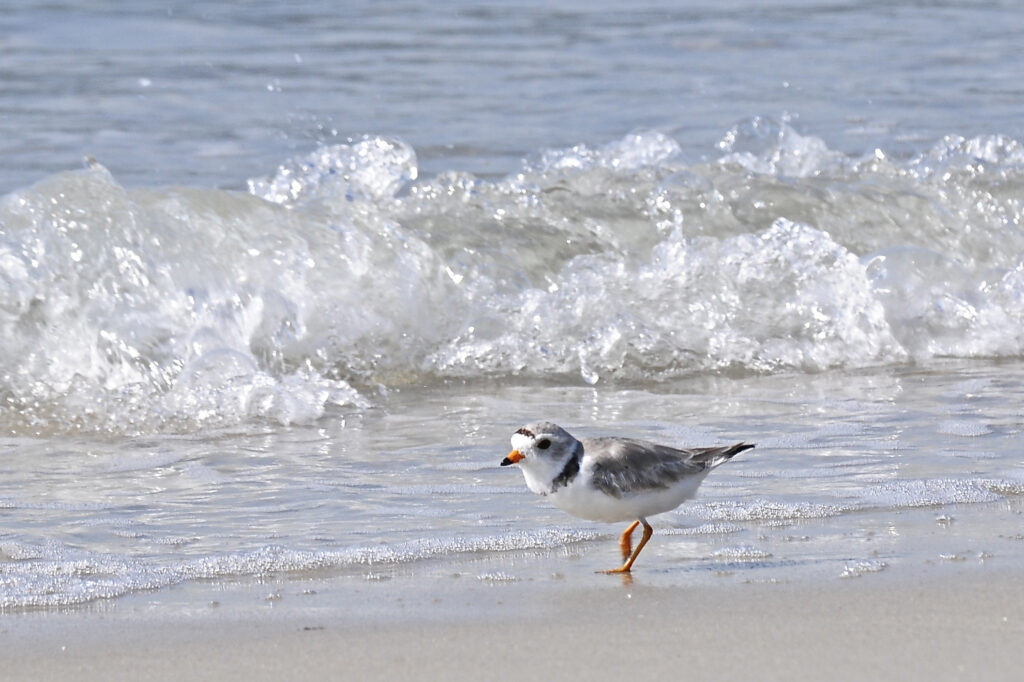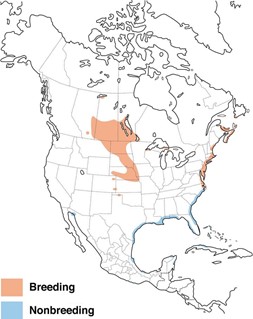Piping Plover (Charadrius melodus)
Atlantic population: Threatened (Massachusetts status and Federal status)
They are a protected species under the Endangered Species Act as of January 10, 1986 and the Migratory Bird Treaty Act of 1918
Northern Great Plains: Threatened
Great Lakes Population: Endangered
Summer on Great Plains and along Great Lakes
Winter along Gulf of Mexico

Appearance:
- 15-inch wingspan
- 7 inches long
- Breeding: sandy-colored back, white underparts and rump, a black upper tail, a black breastband, a black brow band, orange legs, and an orange bill with a black tip
- Nonbreeding: lose their black bands, legs fade to pale yellow, and bills become mostly black
Habitat:
- Nest on coastal beaches, sandflats, gently sloped foredunes, sparsely vegetated dunes, blowouts, and washover areas
- Winter on South Atlantic, Gulf Coast, and Caribbean beaches and barrier islands, on intertidal beaches with no or very sparse vegetation
Range:
- Breeding range extends from Newfoundland to North Carolina; Great Plains and Great Lakes
- Winter range extends from North Carolina to Gulf of Mexico and Caribbean
- 1/3 of Atlantic population winters in Bahamas at Joulter Cays National Park
Nesting:
- Males first return to MA nesting sites late March to April
- Same breeding and winter sites each year
- Wide, barren, sandy beaches, usually prefer areas with scattered grass clumps
- Among small rocks, protective clumps of grass, or completely in the open
- Can be found near sparse vegetation near overwash fans, blowouts, on dredge materials, and above the high tide line
- Scrape is a hollow in the sand, sometimes lined with pebbles or small bits of shell
- If the first nest is lost due to predation or the weather, the females will lay another clutch (up to five can be re-laid in one season)
Eggs:
- Lay eggs mid-April through mid-August
- 4 eggs in 1 clutch
- Gray to pale sand-colored eggs with a few dark spots
- Eggs hatch within hours of each other
- 25-28 days to hatch after being laid
- Both parents share incubation responsibilities for eggs
Chicks:
- Can run .5-mile first day of hatching
- Depart the nest in a matter of hours and begin running over the beach
- Feed themselves the day they hatch (precocial)
- Fledge (fly) within 23-28 days
- Chicks remain together with one or both parents until they fledge
Food:
- Insects, crustaceans, mollusks, sandworms, and other small marine animals
- Tidal flats and intertidal zones of both ocean facing and bay-side beaches (especially wet sand areas) and wrack
Lifespan:
- Five years, but can live up to 14 years
Migration:
- Leave southward starting late July through mid-October
Behavior:
- Males establish territories soon after they arrive on their breeding grounds
- Males court females by tipping side to side in flight with deep and slow wingbeats above their territories. On the ground, males toss shells and pebbles aside and kick away sand to form a small depression that may be the future nest site. Males also tilt their body, spread their wings, and fan their tail in front of a female. Prior to mating, males high step around the female Piping Plovers form monogamous pairs during the breeding season, but often change mates the following year
- If they spot a predator near the nest, they try to lead it away by feigning injury, usually a broken wing
- Run quickly along the beach stopping frequently to pull or pick an invertebrate from the sand
- After the eggs hatch, both parents brood the chicks
Reasons for population decline:
- Excessive hunting for the millinery trade
- Climate change- rising tides and erosion
- Their nests accidently get stepped on or crushed by people and vehicles
- The presence of people also may cause the birds to desert the nest, exposing eggs or chicks to the hot sun and predators
- Interruption of feeding may stress juvenile birds during critical periods in their life cycle
- Pets, especially dogs, may harass or kill the birds
- Many of the coastal beaches traditionally used by piping plovers for nesting, feeding, and roosting have been lost to commercial, residential, and recreational developments
- Developments near beaches provide food that attracts increased numbers of predators such as racoons, skunks, and foxes
- Water level manipulation along the major rivers may also lead to loss of breeding habitat
Lifecycle:
- Reach sexual maturity in one year
- Male first to reach breeding grounds, where they build several scrapes for females
- Females lay 4 eggs in a clutch
- Eggs hatch after 25+ days
- Chicks immediately forage for food and fledge after 25 days
- Leave for winter area late July through September and in some rare cases October
Symbolic Fencing:
- Put up before plovers migrate to breeding ground (early/mid-March)
- Use fiberglass poles
- Place every 20-24 feet
- 3 rungs of orange roping attached to the poles, extending all around the perimeter. One rung at 12 inches above ground, one rung at about 24-30 inches above ground level, and the top rung at four feet above ground level
- On beaches where pedestrians, joggers, sun-bathers, picnickers, fishermen, boaters, horseback riders, or other recreational users are present in numbers that could harm or disturb incubating plovers, their eggs, or chicks, areas of at least 50 meter-radius around nests above the high tide line should be delineated with warning signs and symbolic fencing
- However, fencing around nests should be expanded in cases where the standard 50 meter-radius is inadequate to protect incubating adults or unfledged chicks from harm or disturbance
- In cases where the nest is located less than 50 meters above the high tide line, fencing should be situated at the high tide line, and a qualified biologist should monitor responses of the birds to passersby, documenting his/her observations in clearly recorded field notes. Providing that birds are not exhibiting signs of disturbance; this smaller buffer may be maintained in such cases
Other Resources:
